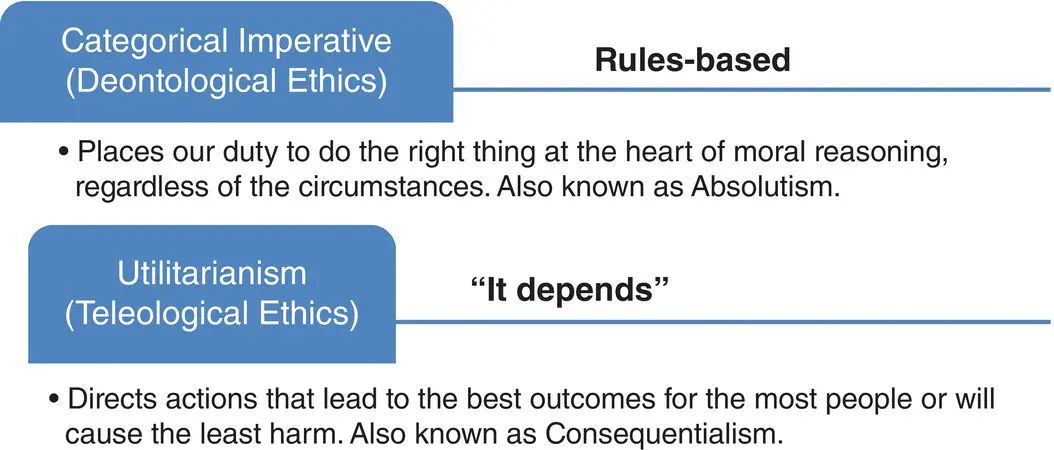1 ...8 9 10 12 13 14 ...17 Even the choice as to whether to run a photo or include a video in a news story or other media representation has ethical implications as well. Of course, the issue raised earlier about graphic video and imagery is one that journalists frequently confront. How many, if any, photographs of a tragedy should be included?
Foundations of Ethical Thought
Your grounding in ethics likely emerged from your upbringing – the mores of your family, religious institutions, school, and family – and even the media you use. It may be useful to begin with reflecting on your own beliefs and approaches to dealing with ethical dilemmas. Most of us respond instinctively in such situations and think we “just know” the right thing to do. However, our instincts can lead us down problematic paths. This risk is why a system of reasoning about complex situations is helpful. Ethicists tend to fall into two main camps known as “ deontological” and “teleological” (Figure 2.1).
Think of deontological ethics as rules based. Deontology is based on the Greek word for duty. Deontological ethicists insist that regardless of the situation, individuals should adhere to moral rules that either require or prohibit certain types of action, regardless of the consequences. We can also think of these rules‐based people as being absolutist in that they often rely on religious tenets or other deeply held values that, in their view, can never be broached. For instance, a photojournalist who believes that they are duty bound to provide photos depicting a “newsworthy” event, regardless of whether others might be injured or shocked in some way, would be an absolutist.

Figure 2.1 Categorical imperative and utilitarianism.
Source: © John Wiley & Sons, Inc.
Deontology, also called absolutism, places our duty to do the right thing at the heart of moral reasoning, regardless of the circumstances. For instance, an absolutist believes that it is never right to lie so presumably if a crazed killer breaks into your house and demands to know where you keep the knives, you would be duty bound to tell the truth. This, of course, sounds extreme, but carried to its ultimate conclusion, that is where deontology takes us and why many people don't think it passes the “real‐world” test.
Does the end justify the means? The absolutists will say no. Immanuel Kant is the most famous proponent of this view described as the categorical imperative. Kant believed that each of us should start with the premise that people should only behave in ways that they would want others to behave. In other words, we should act as if our own ethical choices were universal law. As Patterson and Wilkins (1997) explain, the test of a moral act is its universality – whether it can be applied to everyone.
In contrast to deontology, think of teleological as “it depends.” Ethical theories can be categorized in terms of those theories' basic guiding principles (Black and Roberts, 2011). These principles bring different values to the fore and influence our ethical decision‐making.
Teleology, also known as consequentialism, focuses on outcomes or ends and is at the root of utilitarianism, a well‐known philosophical approach to moral reasoning. We ask ourselves “what are the possible results of choosing one decision over another?” “What happens if I favor one value instead of another?”
The core of decision‐making for utilitarian thinkers involves what actions will lead to the best outcomes for the most people or will cause the least harm. One of the ways we commonly do this is to focus on outcomes, known in ethicist lingo as “consequentialism.” By that, we mean that we think about what will happen if we choose one course of action over another.
For instance, if an advertising agency’s creative director wants to use a video of a person base jumping from a skyscraper to dramatize the thrilling taste of a soft drink, they may indeed be successful in gaining the attention and interest of members of a target audience and thus have greater success in selling the product. On the other hand, they may also want to take into account that depictions of potentially dangerous behaviors may encourage others, especially vulnerable audiences, to emulate that behavior. A 12‐year‐old boy whose judgment is not highly developed may see the video and believe himself capable of doing the same thing.
While at first blush utilitarianism seems logical and fair, it’s often criticized for ignoring the needs and concerns of those who aren’t in the majority. Critics also say that utilitarianism lets people off the hook by ignoring our fundamental human responsibility to make ethical choices. And, as Black and Roberts (2011) point out, it's problematic to expect people to be able to accurately imagine and predict the outcomes of these decisions.
The categorical imperative (deontology) and utilitarianism (teleology) are often envisioned as being on the opposite ends of the spectrum of moral thought. The ideas of W.D. Ross provide different perspectives that many people believe bridge the gap between absolutist and consequentialist views of ethics, offering a pluralisticviewpoint ( Figure 2.2). Ross (1930/2002) argued that we often are faced with competing values as we consider ethical questions. He provides moral guidelines that he calls prima facie duties. The term prima facie literally means “on its face” (at first glance) in Latin and refers to the concept that certain duties and obligations come first unless other contingencies or issues come up.
Ross lays out these duties in his book, The Right and the Good (1930/2002):
Fidelity: the need to keep promises and avoid lying and deception.
Reparation: the requirement to ameliorate or “fix” actions we may have made that were wrong and injured others.
Gratitude: the duty to be thankful for others' good acts and to act positively in return.
Non‐injury and harm‐prevention: the responsibility to avoid hurting other people and to forestall harm where possible.
Beneficence: the duty to do our best toward others, recognizing that in doing good toward others and holding that there are people in the world “whose condition we can make better in respect of virtue, or of intelligence, or of pleasure.” Figure 2.2Ross’s seven prima facie duties (pluralism ethics) “At first glance.”Source: © John Wiley & Sons, Inc.
Self‐improvement: a responsibility to ourselves to foster our own well‐being, health, and safety.
Justice: the duty to behave in ways that ensure happiness and pleasure are distributed fairly among all people. (Ross, p. 21–22).
One way to understand Ross's ethics theory and the role of contingencies is to consider the analogy of a card game. When you look at a newly dealt hand, at first glance you might think that you will win in a “top card wins” game because you have an ace. However, you might end up losing if another player has a trump card. This can be any card in the deck, but the players have determined beforehand that this card will beat, or trump, any other card, even the ace.
Now consider Ross's ideas on a person's moral duties. Most situations will involve more than one duty. Often, they will conflict, causing you to deliberate which one to follow within a specific situation. While this seems confusing, using personal moral judgment to weigh decisions based on the context of a given situation can be more useful than being bound by clear‐cut rules and answers. Can you think of a situation involving visual communication that you would decide by weighing Ross's seven duties? Consider what content you'd use to cover a fast‐moving news event like a salmonella outbreak, or what images you'd use in a fund‐raising campaign to fight childhood malnutrition.
Читать дальше













